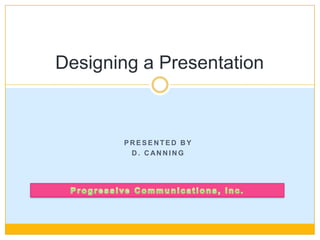Designing a presentation
- 1. P R E S E N T E D B Y D . C AN N I N G Designing a Presentation
- 2. Designing a Presentation ď‚— Identify the purpose of the presentation ď‚— Identify the audience ď‚— Identify the goals you expect to achieve ď‚— Evaluate the content ď‚— Establish a format and use it 11/18/2005 2 D. Canning FIT 1000
- 3. Purpose of Presentation  Capture attention and explain concept  Graphics help people remember  10% of what they read  20% of what they hear  30% of what they see  70% of what they see and hear 11/18/2005 3 D. Canning FIT 1000
- 4. Identify Audience Characteristics of audience determine which presentation media to use • Overheads best for lighted rooms and for group size less than 40 • Electronic presentation to any size audience • 35mm slides for formal presentation to any size audience 11/18/2005 4 D. Canning FIT 1000
- 5. Identify Goals If selling a product, focus on why product is best for this audience If presenting a study, give the results rather than a history of the study 11/18/2005 5 D. Canning FIT 1000
- 6. Establish Format and Use It  Be consistent with color attributes  Use bold and italics sparingly  Use no more than two font types and styles  Remember:  K.I.S. (Keep It Simple)  C.C.C. (Clutter Creates Confusion) 11/18/2005 6 D. Canning FIT 1000
- 7. Technology in Presentations 11/18/2005D. Canning FIT 1000 7 Software Photo Shop  Dreamweaver Flash  Web Documents PowerPoint Hardware  Laptops  Projectors  LCD Monitors  Kiosks  Flat Screens  Movie Screens
- 8. Web Presentations HTML Presentations Hypertext Markup Language Internet Access Web Browser Notepad Dream Weaver Internet Connection 8 11/18/2005D. Canning FIT 1000
- 9. Life Cycle of Presentations 11/18/2005D. Canning FIT 1000 9








